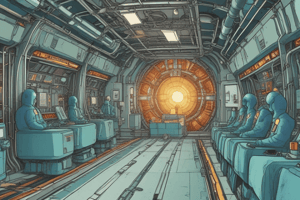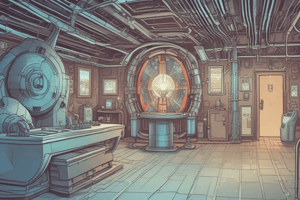Podcast
Questions and Answers
What is one of the health conditions treated by nuclear medicine?
What is one of the health conditions treated by nuclear medicine?
- Diabetes
- Hyperthyroidism (correct)
- Osteoporosis
- Asthma
What is a common term for a radionuclide used in nuclear medicine?
What is a common term for a radionuclide used in nuclear medicine?
- Radiosensitizer
- Radioisotope
- Radiopharmaceutical (correct)
- Radiological agent
Which type of scanner is primarily used to detect radiation emitted from radionuclides?
Which type of scanner is primarily used to detect radiation emitted from radionuclides?
- Magnetic resonance imaging
- Computed tomography
- Gamma camera (correct)
- Ultrasound scanner
What are the areas in a scan where radionuclides collect in greater amounts called?
What are the areas in a scan where radionuclides collect in greater amounts called?
Which type of scan is specifically used to assess the health and function of the kidneys?
Which type of scan is specifically used to assess the health and function of the kidneys?
Single photon emission computed tomography (SPECT) differs from planar imaging in that it provides:
Single photon emission computed tomography (SPECT) differs from planar imaging in that it provides:
Which type of scan is often combined with mammograms to detect breast cancer?
Which type of scan is often combined with mammograms to detect breast cancer?
What substance type is dependent on the body part being examined for a nuclear medicine study?
What substance type is dependent on the body part being examined for a nuclear medicine study?
Which scan is used primarily to identify tumors or abscesses?
Which scan is used primarily to identify tumors or abscesses?
Flashcards
What is nuclear medicine?
What is nuclear medicine?
A specialized area of radiology that uses small amounts of radioactive substances for diagnosis and treatment of various conditions, including cancer.
What is a radionuclide?
What is a radionuclide?
A tiny amount of radioactive substance used in nuclear medicine procedures, also known as a radiopharmaceutical or radioactive tracer.
What are 'hot spots' in a nuclear medicine scan?
What are 'hot spots' in a nuclear medicine scan?
Areas where the radionuclide collects in greater amounts, appearing brighter on a scan.
What are 'cold spots' in a nuclear medicine scan?
What are 'cold spots' in a nuclear medicine scan?
Signup and view all the flashcards
What is planar imaging?
What is planar imaging?
Signup and view all the flashcards
What is SPECT (Single Photon Emission Computed Tomography)?
What is SPECT (Single Photon Emission Computed Tomography)?
Signup and view all the flashcards
What is a renal scan?
What is a renal scan?
Signup and view all the flashcards
What is a thyroid scan?
What is a thyroid scan?
Signup and view all the flashcards
What conditions can Nuclear Medicine treat?
What conditions can Nuclear Medicine treat?
Signup and view all the flashcards
What are the phases of a Nuclear Medicine Scan?
What are the phases of a Nuclear Medicine Scan?
Signup and view all the flashcards
How long does a nuclear medicine scan take?
How long does a nuclear medicine scan take?
Signup and view all the flashcards
What is a Radionuclide Angiogram?
What is a Radionuclide Angiogram?
Signup and view all the flashcards
What preparations are made for a resting RNA scan?
What preparations are made for a resting RNA scan?
Signup and view all the flashcards
How are red blood cells 'tagged' in a resting RNA scan?
How are red blood cells 'tagged' in a resting RNA scan?
Signup and view all the flashcards
What happens after the red blood cells are 'tagged'?
What happens after the red blood cells are 'tagged'?
Signup and view all the flashcards
Study Notes
Nuclear Medicine Overview
- Nuclear medicine is a specialized area of radiology
- It utilizes small amounts of radioactive substances (radionuclides or radiotracers) for medical research, diagnosis, and treatment, including cancer.
Radionuclides
- Radionuclides, also known as radiopharmaceuticals or radioactive tracers, are administered in small amounts during a scan.
- They are absorbed by body tissue.
- Several types exist, including forms of technetium, thallium, gallium, iodine, and xenon.
- The specific radionuclide used depends on the type of study and the body part being examined.
Working Principle
- After administration, the radionuclide releases radiation.
- A radiation detector (e.g., gamma camera) detects this radiation.
- Digital signals from the detector are processed by a computer, creating images.
Image Interpretation
- Areas where the radionuclide accumulates are termed "hot spots".
- Areas where the radionuclide is not absorbed are "cold spots".
- Hot spots appear brighter, and cold spots appear less bright on the scan.
Planar and SPECT Imaging
- Planar imaging uses a stationary gamma camera for 2D images.
- SPECT (Single Photon Emission Computed Tomography) involves a moving gamma camera to produce detailed 3D images of an organ.
Types of Scans
- Renal scans: Assess kidney function and blood flow.
- Thyroid scans: Evaluate thyroid function or identify nodules/masses.
- Bone scan: Evaluate joints (for arthritis), and bone conditions (diseases, tumors).
- Gallium scans: Diagnose infectious or inflammatory diseases, tumors, and abscesses.
- Heart scans: Assess heart blood flow, function, and damage after a heart attack.
- Brain scans: Diagnose brain issues or problems in blood flow to the brain.
- Breast scans: Often used with mammograms to detect breast cancer.
Uses
- Nuclear medicine treats various medical conditions, including hyperthyroidism, thyroid cancer, lymphomas, and bone pain from certain cancers.
Procedure Steps
- Phase 1: Administration of the tracer (radionuclide).
- Phase 2: Obtaining images of the body.
- Phase 3: Interpreting the obtained images.
- Scan duration varies depending on the body part and the tracer. Some scans may be performed minutes after administration, while others might need multiple sessions over several days.
- Pre-procedure instructions may include removing metal objects and potentially clothing, as well as preparation for intravenous (IV) placement.
Procedure Details
- Patient lies still on the table during the scan.
- A gamma camera is positioned over the patient to capture images as blood is pumped through the body.
- Position changes may be required during the procedure.
- IV line and other diagnostic measures (ECG, blood pressure) might be used.
- The IV line is removed afterward, unless otherwise instructed.
Studying That Suits You
Use AI to generate personalized quizzes and flashcards to suit your learning preferences.




